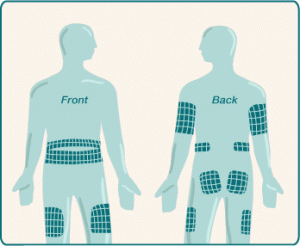 This photo – which I first saw posted on my endocrinologist’s office wall – is disturbing, I admit. It is meant to remind people to rotate injection sites. And I think it’s effective. It’s a photo of a man who gave his injections in these two sites – over and over for years. I apologize for the graphic photo; now on to a discussion of insulin injection sites.
This photo – which I first saw posted on my endocrinologist’s office wall – is disturbing, I admit. It is meant to remind people to rotate injection sites. And I think it’s effective. It’s a photo of a man who gave his injections in these two sites – over and over for years. I apologize for the graphic photo; now on to a discussion of insulin injection sites.
Things to remember:
- insulin goes into the fatty, or subcutaneous, tissue. If you inject insulin into muscle it works really fast and erratically. That can be dangerous and we want to avoid it.
- back in the days of longer insulin needles, we pinched up the fatty tissue to be sure the needle went where we want it to go (not all the way into muscle); now we have short needles and don’t really have to pinch anymore (unless you are using longer needles and you are very thin)
- rotating sites keeps sites healthy and usable for a long time
Here is a picture of injection sites:
Many people only use their abdomen (stomach) because it’s easy and most of us have some extra fat there. It’s important to remember to rotate not just between sites (arms, legs, butt, hips, stomach), but also within sites. The abdomen is a large area – you can go up and down and out toward the sides. The hips (“love handles”) are a great site for injections as well.
Give your sites a break: avoid injecting in the same area day after day – move around. Sometimes it helps to make a “site rotation chart.” And all of this is true for those who use insulin pumps too. Pump infusion sets get inserted wherever you can inject insulin.
Healthy sites can mean more effective insulin absorption and more consistent insulin action. For the best outcomes, choose your sites carefully.

